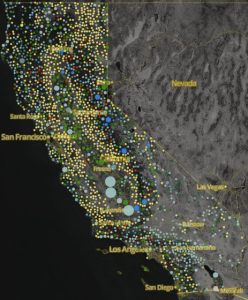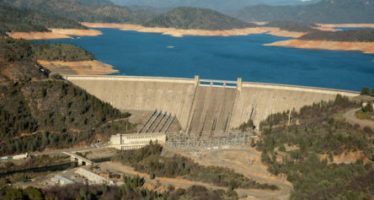New Water Rights Atlas exaggerates CA water problems
By Wayne Lusvardi
The Resource Renewal Institute, an environmental activist organization, recently posted online its new California Water Rights Atlas. The atlas alarmingly asserts:
“Currently, water rights holders claim they divert [that is, use] in aggregate approximately 250 million acre feet of water each year. California receives 71 million acre feet of usable water from annual precipitation.”
The inference is that mainly farmers are over-drafting underground water supplies. But is this accurate?
First, according to the State Department of Water Resources, the amount of average annual rainfall in California is 194.2 million acre-feet, or 2.7 times the atlas’s number of 71 million.
It is widely reported that California gets about 30 percent of its water from groundwater sources. The average amount of water supplied for urban, agricultural and environmental uses in a year is 82.5 million acre-feet, again according to the State DWR. Thirty percent of 82.5 million acre-feet of water amounts to 24.75 million acre-feet, not 71-million acre-feet.
So the Water Rights Atlas understates the amount of average California rainfall by 2.7 times. And the amount of water supplied from subsurface resources is inflated by 2.8 times. Unfortunately, the media have accepted these mistaken estimates as reliable. And the incorrect estimates ignore that groundwater storage capacity is 10 times that of all the state’s surface reservoirs combined.
Groundwater numbers
It is easy to exaggerate groundwater withdrawals during dry years and ignore replenishment during wet years. Water activists often don’t see that farm water is not equal to the sum of groundwater pumping. The consumption of water by crops is much less than the water applied.
The rest of the water recharges the groundwater basin. Installing meters on farm water wells does not “measure” the farm’s groundwater usage, because as much as 50 percent of that may percolate back into the groundwater table.
Is a catastrophe looming to justify statewide monitoring and regulating of farmers’ legal rights to use uncontaminated water on their own properties? Some analysts, including Peter Gleick of the Pacific Institute and Catherine Freeman of the California Legislative Analyst’s Office, assert that unregulated water rights holders are hurting the public and the environment.
But the over-drafting of water basins in Southern California ended decades ago due to adjudications and infusions of imported water. Adjudicated water basins are a model of successful self-regulation.
On the other hand, the Tulare Lake Basin in Central California has overdraft problems during dry years. But this can be addressed locally. A Stanford study by Rebecca Nelson found that groundwater over-drafting is already being addressed at the local level.
The claims of impending catastrophe ignore that local institutions are already in place to protect groundwater. There is little to no recognition, for instance, that the California Groundwater Association, a non-profit organization with 40,000 members, has been operating efficiently since 1948.
Is Water Conservation a Solution or Part of the Problem?
Contrary to popular notions, water conservation efforts have resulted in diminished groundwater recharge. This is because groundwater supplies during dry years rely on irrigation inefficiencies during wet years.
Agricultural conservation leads to what is called the “rebound effect”: the more water that is available due to conservation, the more acres of crops are put into cultivation. There is little recognition by environmental groundwater crusaders that conservation itself, not use, could be the source of any future crisis that they foresee.
Groundwater Catastrophe is Sociological, Not Hydrological
The report of a looming statewide groundwater catastrophe is not only overblown. It reflects a misperception of the important role of farmers in California’s economy and ecology.
In fact, if it weren’t for farmers erecting dikes and levees in the Delta, salmon would “drown” and flooding would periodically ruin Delta ecosystems. Social activism to restore salmon runs — and create new jobs for environmentalists — is now destroying farmers’ jobs in the Central Valley, as I reported earlier this month.
There is a culture water war going on in California over groundwater, green jobs and political power at the expense of agricultural jobs and productivity. This is not to ignore or diminish real groundwater over-drafting problems that can be solved at the local level.
As Jay Lund, professor at U.C. Davis’s Center for Watershed Sciences, has aptly summed up California’s groundwater situation: “Effective management of overdraft, salinization and contamination also will require a long-term perspective and technical efforts — through the end of the 21st Century and beyond. This requires an important, if limited, role for the state.”
It does not require a vast expansion of government regulation.
Related Articles
Measure diverting bullet train funds for water storage hits money shortage, eyes 2018
Proponents of a ballot initiative that would divert high-speed rail funds to water storage projects announced on Friday that the
High-speed rail lawsuits pit CA vs. USA
Like the famous 1860s race to build a railroad across America to California, an epic battle is shaping up
2014 promises water fight over Delta tunnels
Gov. Jerry Brown’s proposed twin tunnels under the California Delta will continue to be a major policy issue throughout 2014





